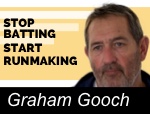|

You show me a fielder who has never had a sore arm or shoulder from throwing and I will assume they "choose" to field at slip, irrespective of the state of the game!
For the rest of us, one thing that helps is learning how to warm up, condition and strengthen your shoulder and arm ahead of pinging the ball in matches or practice.
A few token arm swings just doesn't cut it!
Before we get into that, remember there are many causes of throwing related shoulder and arm pain. It's always worth a technical check. See here and the PitchVision fielding courses such as "First Class Fielding". This will help iron our any technical glitches.
Warming up to throw
Most people think that a few low intensity throws to a mit is the way to prepare the arm for 100% efforts just a few minutes later. This doesn't do the job.
You don’t need a heap of kit to warm up and strengthen the vulnerable shoulder and arm either.
My throwing kit bag is this,
- A piece of theraband tubing. The baseball versions are called J-Bands.
- 1KG med ball.
- Variety of sand filled balls.
The great thing about the J-bands is that you can have them posted just outside the boundary line in a few key positions around the field. Your deep fielders can keep their arms loose and moving at breaks in game time. We attach them to the 3rd man and fine leg boundary fences on Millfield’s main ground.
The J-band routines can be found here.
Here is Millfield and Somerset Cricketer, Tom Diamond doing some of the exercises from the J-band manual.

These are great exercises to do the following things:
- Oxygenates and warms the shoulder.
- Provides a deeper, more isolated workout for the rotator cuff muscles. The rotator cuff is a group of muscles and their tendons that act to stabilize the shoulder. This is also the part of the shoulder that is most likely to break down.
- Strengthens the shoulder from "inside out".
- Optimises elasticity, flexibility and range of motion.
- Provides rotator cuff muscle balance, strength and endurance.
- Fast tracks the recovery period in between performances.
Keep the movements controlled and smooth ensuring that the larger muscles groups including the trapezius are neutral and switched off.
It is easy for the larger muscle groups to take over. If you feel this happening then reduce the tension in the band by moving slightly towards the pivot point.
If time is an issue and you need a speedier warm up then run through this shortened version:
- Reverse flys
- Flys
- Internal rotation
- External rotation
- Elevated internal rotation
- Elevated external rotation
Within a few sessions, you will feel that the shoulder feels more stable, that your internal and external range of movement has increased (which facilitates increased ball velocity) and that you reduce the stress on your shoulder when you move from warm up to throwing in anger.
Warm up to throw: Don't throw to warm up.
Discuss this article with other subscribers
|

.jpg)
.jpg)


.jpg)
.jpg)
